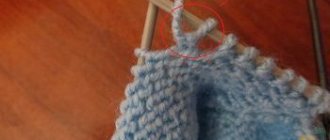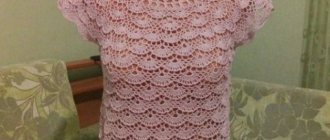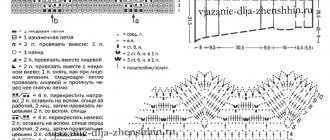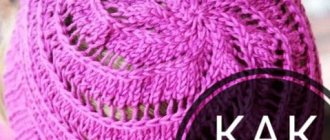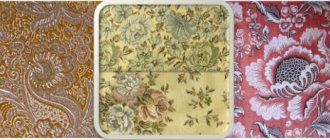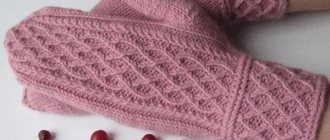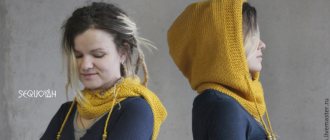Any knitting technique involves a set of loops. There are many ways to do this, which depend on the product, patterns and simply ease of use. One of the varieties is the Italian set of loops. With its help, an elastic edge is created, ideal for knitting elastic for cuffs on the sleeves and along the bottom of the product, as well as for decorating the neckline. The main advantage of this method is a smooth edge, as close as possible to industrial.
For knitting you will need:
- metal knitting needles one size smaller than those that will be used to knit the rest of the fabric;
- high-quality yarn with an even, smooth thread;
- skill - the final result largely depends on skill; you need to constantly monitor the tension of the thread.
For those who are just getting acquainted with this method, it is better to start with the classic method, using an Italian set of loops with knitting needles for knitting 1x1 elastic.
Knitting with one thread
In this case, only one knitting needle is used, which makes the work easier and makes it possible to quickly master the technique. This is done like this:
- the first loop is formed as usual;
- for the second, the thread is grabbed from under the thumb, while the knitting needle rises above the thread from the index finger and extends already under the thread from the thumb;
- the purl loop is formed from top to bottom from the index finger, and then the thread rises up and is grabbed from the thumb;
- This is how a row is knitted, alternating purl and knit stitches;
- In the next row you need to knit only the front loops and remove the purl ones. The row will look upside down.
If you like this set of loops for the elastic edge, you can try a more complex option.
Introduction to technology
The Italian stitch closure technique is also called the needle stitch technique. Use this method if you want the knitted elastic to retain its elasticity after closing the loops and not increase its edge with unnecessary weaves.
When using this technique, the edge, on the contrary, remains very attractive, it is smooth, not protruding and, interestingly, is double-sided.
Such an edge will be simply ideal for covering a detail of an interesting composition. This Italian method is performed with a needle.
Method with additional thread
For the set, you will need an auxiliary thread of a contrasting color or you can use a thin elastic band if you need to make the edge more springy. This technique is often used when making elastic bands for socks or waistbands on thin knitted skirts. The Italian set of loops with knitting needles is done like this:
- the initial loop is knitted in the traditional way;
- the main thread is on the index finger, the auxiliary thread is on the thumb, the threads are fixed with the little finger and ring finger;
- the knitting needle passes under the auxiliary thread and grabs the main thread, forming the first working loop;
- then the main thread is picked up, and the auxiliary thread is placed behind the loop, and the previous point is repeated;
- This way the required number of loops for knitting the product is formed.
The Italian method of casting on loops with an additional thread assumes that in the first row after casting on, the loops will be placed in front of and behind the additional thread. Those that are in front are knitted with knit stitches, while others are removed as purl stitches.
LiveInternetLiveInternet
Quote from tati_mama
Read in full In your quotation book or community!
Italian set of loops for straight and circular knitting.
Italian set of loops for straight and circular knitting.
Italian set of loops with elastic and tight edge.
Italian set loops for circular knitting.
|
Knitting elastic 2x2
This set of loops is well suited for knitting a popular elastic band, where the loops are cast on in multiples. The principle is as follows:
- The first row begins with a front loop, which is knitted behind the back wall, and the purl loop is removed. The thread is placed in front of the loop;
- in the second row, the front loop is formed behind the front wall, the purl loop is traditionally removed. The thread is still located in front of the loop;
- the third row is knitted according to the principle of the second, and the fourth repeats the third.
In the fifth row of the Italian set of stitches for 2x2 rib, we change the knitting needles to larger ones. We knit the purl loops in the classic way, in which the front loops are knitted behind the front wall.
Method 2
When casting on the initial row, the auxiliary contrast thread is not knitted, but pulled through. After five to ten rows you can pull out the auxiliary thread.
English gum
One of the most popular knitting techniques - English rib - is also formed using an Italian set of loops, and an odd number. Then the elastic band itself is knitted, following the principle:
- The front loop is a yarn over, the next one is removed, and so it is repeated until the required number of loops. The working thread remains behind the wall;
- the next row begins with a yarn over, then a loop is removed, and the working thread is placed in front of the wall. The yarn overs of the previous row are knitted with knit stitches;
- then the first loop and yarn over are knitted, yarn over and the loop is removed;
- The second and third rows alternate, forming the desired elastic size.
Winter hat made of wool yarn
Winter knitted hats for children and adults, made on knitting needles with a double elastic pattern, are very warm.
- Measure your head circumference.
- Make a control sample from the model yarn.
- Using the sample, calculate how many loops are needed for the hat.
- Dial the calculated number using the Italian method. Take knitting needles 0.5–1 size smaller than the main part of the hat will be knitted.
- Knit the required number of rows with a hollow elastic band; the height of the cap, depending on the model, is from 24 to 30 cm.
- Divide the work into four parts.
- Work the crown, decreasing stitches at the end and beginning of each part in each odd row.
- Pull the remaining open loops onto a thread. The warm hat is ready.
Circular knitting
The Italian cast-on in the round begins by casting the required number of stitches on smaller needles. Plus one additional loop is cast on to connect the initial row. Afterwards the loops are evenly placed on 4 knitting needles or left on special circular knitting tools.
- In the first row, the front loop is knitted behind the back wall, and the purl loop is removed. The thread is placed in front of the loop.
- In the second row, the front one is removed, and the purl one is knitted. The thread is behind the loop.
- In the third row we switch to larger knitting needles and continue knitting according to the chosen pattern.
Remember to join the stitches in the cast-on row to avoid a gap between the first and last stitch.
Closing the last row of the pattern
Method one. To maintain the elasticity of the closed edge, all removed loops are knitted and closed using the purl method, and the front ones are knitted and closed using the front method. The edge obtained by this method is very elastic and stretches easily, so it is used for knitting collars of sweaters and turtlenecks.
Method two. Closing the edge with the following knitting pattern will allow you to preserve the shape of the part: Two loops are knitted together (one from the face, the second from the back) and pulled through the previous one.
Method three (Italian). After finishing knitting, the long end of the yarn is threaded into the eye of a thick needle. The yarn should fit into the eye of such a needle freely.
- Through the first knit stitch, pull the needle and thread into the second loop (purl stitch), remove both loops from the knitting needle.
- Through the first knit stitch, pass the needle into the next knit stitch, pull the yarn through, and lower the loop.
- Thread a needle through the purl stitch removed into the next purl stitch, pull the yarn through and remove the loop.
- Repeat these steps, alternately tightening knit stitches with knit stitches and purl stitches with purl stitches. To keep the edge elastic, do not pull the thread too tight.
Fourth method. Having finished knitting, you need to divide the work into two parts, leaving the knit stitches on one knitting needle and the purl stitches on the other.
The end of the working yarn is threaded into the eye of a thick needle and the edge is closed with its help.
Pull the needle through the first loop on the knitting needle moving away from you and through the first loop on the second knitting needle from right to left, then lower both loops.
Insert the needle through the knitted loop on the first knitting needle, pull the yarn through both loops from right to left.
Do the same with the second half of the work. Repeat these steps one by one until the entire knitting edge is covered.
Loop closure options
When knitting, you will be faced with closing loops every time, so it is best to immediately familiarize yourself with all kinds of techniques, or at least know what they mean, so that you know which one to use at the right time.
The most common way to bind off stitches is to knit stitches. This method can be used to close any parts, it is of course not completely elastic, but it will leave the part in the same tension as it was connected.
The next method is to close the loops as purl stitches. It is knitted according to the same principle as knitting, but here a purl loop is involved in each manipulation.
A separate method that you should know about is closing the loops using the elastic method. If you knitted, for example, a neck that should stretch a little when worn, then you simply cannot do without this method. It is also very relevant for sleeve armholes.
Having at least such basic concepts about possible ways to close loops, you can learn more about the method you are interested in and, with the help of lessons and master classes, knit great things.
Elastic set of knitting stitches
It is used both to start knitting and to increase the number of loops in a row. With this method, the free end of the thread should be short, only to form the first loop. Cast it on in the usual way onto one needle.
This set of loops gives a very elastic, well-stretchable edge. Suitable for 1x1, and most importantly 2x2 elastic bands.
1. Take the knitting needle with one loop in your left hand, and the other knitting needle in your right. Knit a stitch and throw it over the left needle.
2. In this way, cast on the required number of loops.
Elastic set of loops with knitting needles video
Up
How to knit a super stretch edge
To begin with, we form one st. We place the working thread on top of the index finger, and place its end on the left side of the hand, on the thumb. We hold the knitting needle with the loop in the center.
We bring the knitting needle under the thread on the thumb, grab the second thread from the index finger under it and pull it towards ourselves. As a result, a loop is formed that will be similar to the front one.
Now we move the knitting needle in a downward direction away from us, place it under the thread on the index finger, grab the yarn coming from the thumb, and get a loop similar to the purl one.
We alternate these two stitches throughout the entire row. Important! The penultimate one should be “purl”.
Next we knit an elastic band. We suggest trying to knit a Polish one. To do this, it is necessary that the number of stitches cast on be a multiple of 4 + 2 edge stitches. Odd r. knitted this way: 2 l. p., 2 i. n. Even r. we knit differently: 1 and. p., 2 l. p., 2 i. p... The last one should be the front one!
Watch the video master class:
